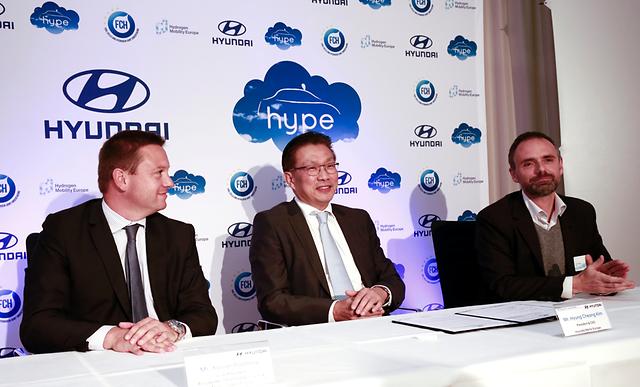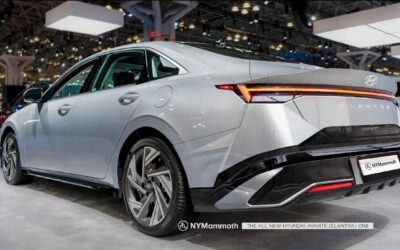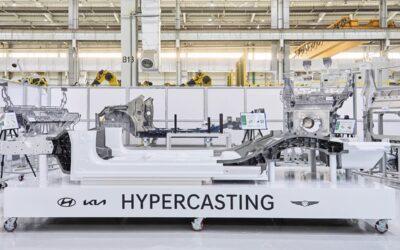 Hyundai Motor will hand over 60 ix35 Fuel Cell cars to the Paris-based electric taxi start-up STEP (Société du Taxi Electrique Parisien).
Hyundai Motor will hand over 60 ix35 Fuel Cell cars to the Paris-based electric taxi start-up STEP (Société du Taxi Electrique Parisien).
[ads id=”0″ style=”float:left;padding:6px;”]Today a memorandum of understanding was signed at the opening of a public hydrogen fuel station operated by Air Liquide at Hyundai Motor’s European headquarters in Offenbach, Germany. The world’s largest fuel cell taxi fleet “hype” (Hydrogen Powered Electric) currently serves the Greater Paris Area with five ix35 Fuel Cell cars that Hyundai Motor delivered in December 2015. The fleet is planned to increase up to several hundred vehicles within five years.
“With the memorandum of today, STEP and Hyundai Motor have committed to bring 60 additional ix35 Fuel Cell taxis to the streets of Paris,” says Thomas A. Schmid, Chief Operating Officer at Hyundai Motor Europe. “Not only will the fuel cell taxis provide a clean transportation solution for the city, they are also a practical, comfortable and reliable choice for drivers and passengers.”
Saving more than 800 tons of emissions
The 60 new ix35 Fuel Cell vehicles will not add to the 17,000 taxis already in circulation in and around Paris. They are replacing petrol and diesel-powered cars. Compared to a diesel-powered taxi with CO2 emissions of 135 gram per kilometre and an annual mileage of 100,000 kilometres, the ix35 Fuel Cell vehicles will save more than 800 tonnes of CO2 per year in exhaust emissions. That is the equivalent of one person taking the plane and flying more than 200 times from Frankfurt to New York and back. In contrast to this, the only emissions from the tailpipe of the ix35 Fuel Cell during driving are water vapour.
Even when it is produced from natural gas, hydrogen is a far cleaner energy than any fossil fuel: for equal distance traveled, hydrogen cars reduce greenhouse gas emissions by 20% compared with internal combustion vehicles and do not produce any fine particles.
Up to 594 kilometres on a tank of hydrogen
[ads id=”0″ style=”float:left;padding:6px;”]The ix35 Fuel Cell is the world’s first mass-produced and commercially available fuel cell electric vehicle (FCEV). Currently there are more than 300 Hyundai ix35 Fuel Cell cars on European roads in 12 countries. That is more than all the FCEVs of other manufacturers combined. Its powerful asynchronous electric motor generates 100 kW (136 PS), and with a maximum torque of 300 Nm it delivers a fun-to-drive experience. Thanks to its efficiency, the ix35 Fuel Cell’s range is up to 594 kilometres on a full tank.
Hydrogen Mobility Europe
The ix35 Fuel Cell deployed are partially funded by the Hydrogen Mobility Europe Project. Hydrogen Mobility Europe is funded by the Fuel Cells and Hydrogen Joint Undertaking (FCH JU), a public private partnership supporting research, technological development and demonstration activities in fuel cell and hydrogen energy technologies in Europe.



